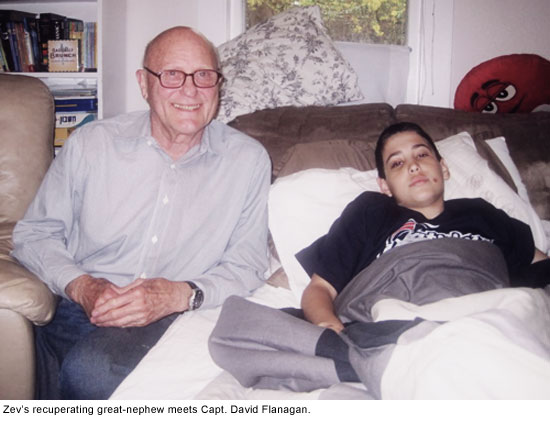When every second counts
May 11, 2011
The email from my sister started with the words: “He’s going to be OK.”
If she hadn’t opened that way, I’m not sure I could have kept my composure as I read what followed:
My 12-year-old great-nephew had been hit by a car as he walked home from school with friends in Brookline, Mass. The driver stopped and was screaming desperately for help when a retired 79-year-old U.S. Coast Guard captain named David Flanagan came on the scene, driving home after a gym workout with his wife.
When Capt. Flanagan saw that my great-nephew wasn’t breathing and had no pulse, he methodically started performing CPR. Happening upon the accident scene within minutes, perhaps even seconds, of the accident may have saved my great-nephew’s life. At the very least, it helped spare him more serious complications from a crash that, as it is, left him with a broken femur, a cracked skull and a major concussion.
Paramedics showed up shortly after, and our “first responder” didn’t hang around for thanks or acknowledgement as my great-nephew was rushed to the renowned pediatric trauma center at Children’s Hospital Boston.
I’m telling this story not just to publicly thank Capt. Flanagan—who despite his modesty represents remarkable courage, decency and skill—but also to marvel at what a difference having rapid access to skilled trauma care can mean, especially for children.
As we voted this week to distribute funds to our county’s trauma and emergency care network, including $1.6 million in startup operating funds for Northridge Hospital’s new Richie Pediatric Trauma Center, my great-nephew’s brush with disaster reminded me of what an important investment that is. The Richie center is the only facility of its kind serving the vast San Fernando Valley, and one of just seven offering this specialized, vitally important care in the entire county. Before the Richie center opened last year, some 300 kids annually had to be transported from the Valley to Children’s Hospital in Hollywood or UCLA’s pediatric trauma center for care. Sacramento has contemplated shifting funds from such trauma centers to help bridge its severe budget gap, but clearly we cannot afford to erode our emergency and trauma network any further.
The “golden hour” in medicine refers to that brief window of time when medical attention can mean the difference between a good outcome and a tragedy. For kids, that window is even smaller because they’re generally less able to compensate for injury and blood loss as effectively as adults. For them, the most good can be done during the “platinum half hour”—and in an area as spread out as the San Fernando Valley, this life-saving resource is long overdue.
My great-nephew spent five days in the hospital and now is back home and on his way to a full recovery. He’ll miss school for several weeks and will be in a wheelchair for a couple of months. Over the phone, I joked with him that the accident had given him good material for his college application essay. He joked back about the Lakers’ playoff humiliation.
I can’t say enough about how much it meant to be able to kid around with him, and how grateful I am to Capt. Flanagan and the professionals who made it possible. (It made all the difference that the captain knew CPR—a reminder to all of us that this is a skill worth learning, and refreshing, at classes offered regularly by the American Red Cross throughout Los Angeles County.)
Of course, we can’t guarantee there’ll be a CPR-trained Good Samaritan passing by every time a kid gets hurt. But by providing funding to the newest member of our county’s pediatric trauma care network at Northridge Hospital, we can greatly improve the odds of injured children getting the help they need—when they need it the most.
Posted 5/11/11













 405 bridge work causes a stink
405 bridge work causes a stink





